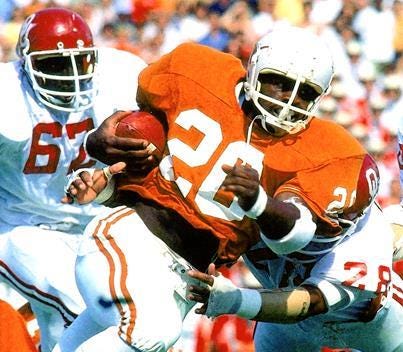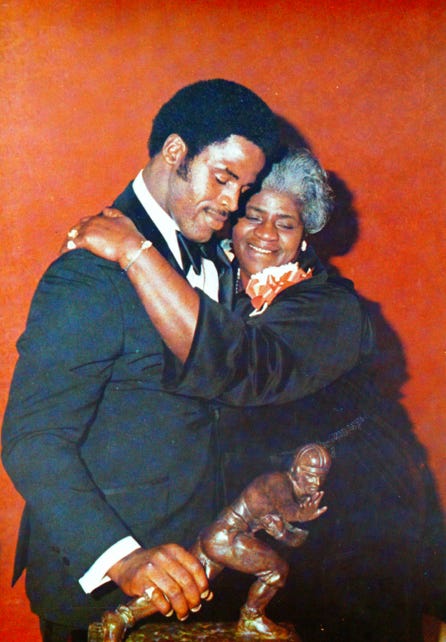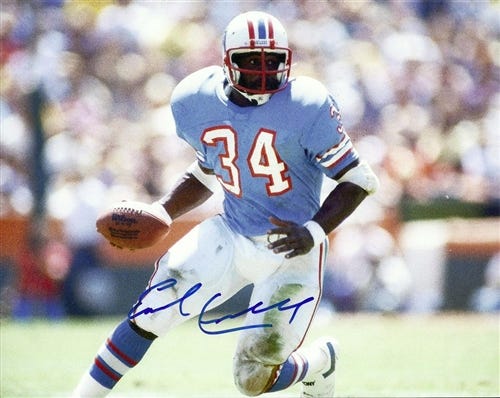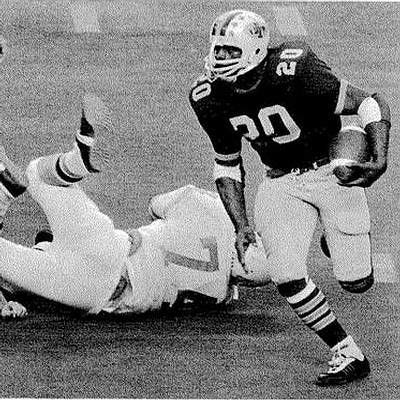The Legend Of The Tyler Rose
Earl Campbell won't be taken down by NFL tacklers or life's major challenges
Sitting in St. Brigid Catholic Church in Alpharetta, Georgia on a Sunday in August of 2009, I listened to a wise old Irish priest begin his homily with the story of Earl Campbell honoring his mother, Ann, at the Heisman Trophy award presentation. The priest dedicated the entire homily to Earl and how he was a great role model for children honoring their parents. It brought a big smile to my face. Later that day, I called Earl to let him know how that one act of love, honor, and respect for his mother on December 9, 1977 continued to resonate 30 years later.
Earl most certainly loved his mother. I had the opportunity to see it first hand at their home in Tyler, Texas which he built for her after signing his first NFL contract with the Houston Oilers. He was selected number one in the 1978 NFL Draft by the Oilers after they traded Jimmie Giles and their first and second round picks in that draft to get the Texas Longhorns standout. Giles went on to do well with Tampa Bay and the Bucs selected quarterback Doug Williams and running back Johnny Davis with those draft picks, so both teams benefited from the trade.
I met Earl’s mother and several of his siblings in Tyler and walked through the hot rose fields the family labored in to earn their living. I also I received a tour of the town and John Tyler High School where Earl first grabbed the attention of the country leading his high school team to the 1973 Texas State Championship.
The city of Tyler and the high school were seriously divided by racial tension back then when busing of black students into white schools resulted in loud arguments and fist-fights in the hallways. Earl found himself confronted by a very big strong white football player named Len King. I wondered at what point King realized picking a fight with Earl Campbell was a bad idea. They ended up teammates and friends as they worked toward that state title.
Whereas the protests and fights against busing were heated, once the team started winning, everyone came together. And Earl Campbell was the star running back who couldn’t be stopped on the football field. He was already becoming a legend in the great state of Texas, where he would later be honored as an official State Hero along with Davy Crockett and Stephen F. Austin.

Following the state championship win in the new Houston Astrodome, the college offers came into the Campbell home. There wasn’t any confusion or discussion about where he would be going to school. Earl Campbell loves Texas, loves being a Texan! Wearing a University of Texas uniform was the perfect fit for him. It was the only uniform that would fit his incredible physique as well as his heart and soul.
Despite being the most sought after recruit in the nation, Earl drove to Austin the same poor kid he was in Tyler. Money for extra food, or to do his laundry, was sparse. Although many of the Texas alumni would have gladly had Earl driving in a Cadillac and living at the Ritz, NCAA rules were clear and wouldn’t be crossed for fear of sabotaging a chance to win the NCAA National Championship. So throughout his college years, Earl had to make due while becoming a major college star, especially in his senior year.

At the Heisman Trophy presentation at the Downtown Athletic Club in New York, he stood smiling at the podium, holding the trophy. The first words out of his mouth were to honor his mother, who was smiling widely in the audience watching her son receive college football’s greatest honor. He knew what she had been through since his father, Bert (B.C.), died in 1966 when Earl was only 11. It’s hard to imagine how Ann Campbell was able to raise and support her 11 children, Earl the sixth oldest. But they banded together as a family and made it work, toiling in the rose fields of Tyler.
Earl started playing football when he was in fifth grade as the team’s kicker. What? Yes, it’s true. He moved to linebacker in sixth grade and that’s really the position he thought he would be playing, since Bears’ great Dick Butkus was his favorite player. Earl performed very well, but always said he was the third best football player in his family. And perhaps some would believe he was just being polite. But when I met his brothers, it became very clear very quickly that all of the Campbell boys were big, strong men blessed with incredible athleticism. At their births, instead of saying, “It’s a boy!” I wonder if the doctor wanted to announce, “It’s a linebacker!” Or, “It’s a defensive end!” All the Campbell boys were blessed with God-given athletic talent to be sure!

The day Earl was selected by the Oilers in the first round was the day he and his family could stop worrying about money. Well, at least for a little while. He signed a contract for $1.4 million for 6 years. Imagine what he would have been paid today. But for a kid who had been dirt poor up until that point, he must have felt like he would never have to worry where his next nickel would be coming from for the rest of his life.
I was blessed to meet Earl in 1993 when my client at The Upjohn Company gave me an assignment to conduct publicity support for Earl’s talks about panic and anxiety disorder, an illness he was diagnosed with two years after retiring from the NFL in 1986.
Traveling with him from city to city for his talks, we became friends and then the idea of writing a book about him to tell his story on a wider scale was pitched to me. My writing experience up until that point was newspaper and magazine articles. I wasn’t certain I could write a book, but given this opportunity, I certainly wasn’t going to decline it.
For the next few years, I spent a good deal of time in Texas with Earl and his family. I interviewed everyone he knew that could help add to his story. The goal was to write a full biography but focus on his battle with panic and anxiety. Why? Men who suffer from panic disorder often commit suicide. Earl nearly did as well on a hunting trip, while sitting in his Suburban holding a loaded rifle ready to end the pain once and for all. Thankfully, he called his twin brothers, Tim and Steve, who talked him out of it.
Then, Earl sought help from medical professionals which eventually led to a meeting with psychiatrist, Dr. Larry Hauser. That one decision has allowed him to see his boys, Christian and Tyler, grow up, graduate from high school and college, and build their own lives.
The past two decades haven’t exactly been a time of wine and roses for Earl. He has suffered many other health issues, some genetic, some from his days running north and south on the football field. Living in constant pain has taken a toll on him and he finds himself in a wheelchair today. But somehow, he has survived chronic pain, arthritis, spinal stenosis and addiction to pain killers. He remains a man of strong faith and feels blessed that he has lived to see it all with his high school sweetheart and wife, Reuna.
Unlike Earl however, many men won’t seek help from a psychiatrist because of the stigma attached. You went to a psychiatrist? A shrink? You’re crazy! You’re nuts!
No, he was smart! And, he lives today because of that wise decision.
In The Earl Campbell Story, I wrote his full life’s story so readers would know who Earl Campbell was before he was diagnosed with panic disorder. Not everyone follows football, so I thought it important that they knew his history and accomplishments. He was the 1979 NFL Most Valuable Player and three-time Offensive Player of the Year (1978, 1979, 1980). He was inducted in the NFL Hall of Fame in 1991 and is widely considered one of the most powerful running backs in the history of the game. The main message of the book: If Earl Campbell, a big, strong, powerful man can seek help, then any man can seek medical help without being embarrassed.
Earl didn’t have to talk about his battle with panic or allow me to write a book about him. But he did. And he made that decision, because despite the celebrity he gained and the many challenges he has faced throughout his life, he remains a good man. I know he is sincere. I was with him outside the spotlight when he would go visit this old man in Austin, brought him something to eat, and talked with him for a while just to lift his spirits.
Today, he is the same guy that honored his mother at the Downtown Athletic Club. He is the same man who scored 74 NFL touchdowns, but never danced in the end zone, preferring to look like he had been there before. Understand, he still can’t go outside of his home without fans approaching him, telling him how great he was on the football field and asking for autographs. He smiles, says “Thank you!” and keeps moving forward in life as the legend of the Tyler Rose continues to grow with each passing year.
Here are some of Earl’s greatest highlights.





This article about Earl Campbell really captures the essence of his journey—both on and off the field. It’s inspiring to see how he not only dominated in football but also overcame personal struggles with such resilience. It reminds me of other athletes who had significant impacts on multiple areas of life, much like <a href="https://urbansplattr.com/chuck-connors-net-worth/">Chuck Connors and his remarkable career</a>, who made his mark not only in sports but also in acting. Athletes like Campbell and Connors show that their influence goes far beyond their athletic achievements, leaving lasting legacies in various aspects of life.